

|
|
 |
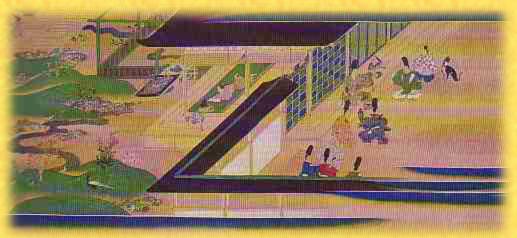 |
The Heian Period in the history of Japan is
often referred to as “the golden age.” It lasted from the 9th through the
12th centuries and preceded the medieval era of shoguns and samurai.
The Heian Age was characterized by relative peace and stability and a central government in the capital, Heian-kyo, by an emperor and the court aristocracy. It is the historical background for both the Akitada mystery series (11th century) and the novel The Hollow Reed (12th century).
|
|
Nobleman's House |
|
|
Sugawara no Akitada Sugawara no Akitada (in Japan, the family name comes before the given name, and the "no" is an obsolete link in noble names) is thought to have been born in 989 A.D. into a family of scholar officials (for his precise parentage, see THE HELL SCREEN). His childhood and early teens were spent in the family mansion in Heian Kyo (the capital of Japan at the time and modern Kyoto) as the only son of a minor functionary in the imperial administration. Following in his father's footsteps, he attended the imperial university (for
details about university life, see RASHOMON GATE) just south of the
Daidairi, or Greater Palace, where his father and hundreds of other nobles
worked in the offices of various ministries and bureaus. |
| The People of Heian Japan:
In Akitada's time only two classes -- nobles and commoners -- existed, but there was also an underclass of "non-persons," the slaves and outcastes. Akitada was born one of the "good people," though he clings rather desperately to the bottom rung of that ladder. Perhaps it is this fact which gives him a greater closeness to and understanding for the less fortunate and causes him to keep breaking rigid social rules to associate with them. |
|
|
Servants |
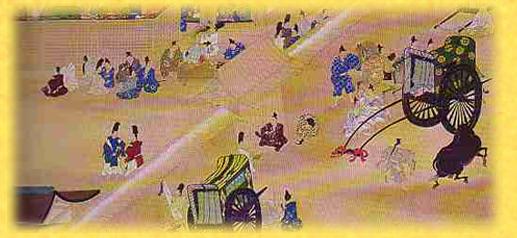 |
Those above him in rank are far more powerful nobles, in particular members of the Fujiwara clan, one branch of which (the sekkanke) furnished the chancellors and senior ministers, most of the imperial consorts, and filled many other upper level positions in the central and provincial administrations. Those below him are peasants, merchants, artisans, and soldiers. Of these, the peasants were the poorest but most highly respected because they fed the nation. |
|
Carriages at the Gate |
|
The merchants and artisans lived in the cities and sometimes became prosperous, especially if they dealt wholesale in rice, silk, or sake, or if they practiced a valued skill, for example sword making. Among the slaves and outcastes were entertainers, laborers,
and workers in despised trades (for example, butchery, leather-working, or
handling the dead. This class originated probably from early prisoners of
war, condemned criminals, and natives of the northern territories; it was
perpetuated through birth and practice into the present day. Beside the lay population, there was also the clergy which was essentially classless, but had its own ranks. There were Shinto priests and priestesses and Buddhist monks and nuns. Akitada, somewhat uncharacteristically for a nobleman of his period, dislikes and distrusts Buddhism and prefers the native Shinto beliefs. |
|
|
Visit to a Shrine |
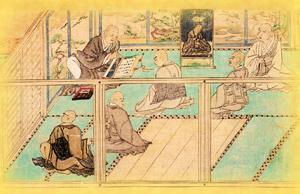 |
Since both faiths played an enormous role in the lives of high and low, Buddhist and Shinto clergy were common and visible in society. Shinto priests were attached to Shinto shrines but participated in many public rituals. They could marry, and their functions were often hereditary. Buddhists clergy, who came from all classes, were supposed to be celibate. Because many noble persons and emperors gave up the “world” in old age or because of serious illness or, in the case of women, because their husbands died, the highest-ranking Buddhist clergy came from the ruling class. Apart from those who lived in monasteries, Buddhist clergy also served as village priests or wandered the roads, begging and preaching. |
|
Monks |
|
Towards the end of the Heian age, large monasteries became increasingly warlike, maintained armies of warrior monks, attacked rival institutions, and took sides in secular politics. Akitada encounters warrior monks in THE DRAGON SCROLL.
|
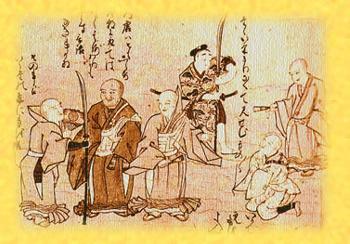 |
|
Warrior Monks |
|
The Ancient Capital During Akitada’s time, the capital of Japan was Heian Kyo, the modern Kyoto. Founded in 794, it remained the capital until the 13th century and the seat of the emperor until 1869. In plan, the capital was very similar to the great Chinese capitals like Chang-An, and followed the Chinese belief that cities needed three mountains nearby – to the north, west, and south. They also needed rivers to the west and east, and a
large pond to the south. The reasons for these geographic features
were based on fears of evil influences which could approach a city from all
sides. |
|
|
|
Such orderliness of planning pervaded much of the political thought of the time, and Akitada is thoroughly versed in the teachings of Confucian order and harmony. He strongly disapproves of disorder. In Heian-kyo, the imperial residence (dairi) was part of the greater imperial city (daidairi) which encompassed all the government buildings and offices. It was walled and gated, as was the larger enclosure, the various ministries, and many of the noble mansions that surrounded the imperial city |
|
The city itself, however, was merely enclosed by a moat and ramparts. Its main southern gate, Rashomon, means “rampart gate.” From the huge, two-storied Rashomon, Suzaku Avenue (80 yards wide, with a central canal and lined with willows) led north to Suzakumon, the gate into the imperial city. To the right and left of Rashomon stood two Buddhist temples, To-ji and Sai-ji, with five-storied pagodas. About halfway to the palace, to the east and west, two enormous market places served the people of Heian Kyo. |
 |
Closer to the palace were the east and west administrations of the capital, the university, and a large park. The quarters on either side of the imperial city were originally reserved for the ranking nobles, but the western quarter declined early. Akitada works inside the imperial city in the Ministry of Justice, more than likely a large hall with wings that stood inside its own walled and gated courtyard. His residence is in the north-eastern quarter, a typical nobleman’s house in a walled enclosure, with separate pavilions, covered galleries, and outbuildings, such as stable and kitchen. Though large and in a good neighborhood, it is in constant poor repair and sadly under-staffed because the family has fallen on ill times. In spite of the careful planning along the lines of Chinese ideals, the real world and the character of the Japanese people soon asserted themselves in Heian Kyo. In the precise plan of the capital all sorts of charming irregularities appeared. Small rivers and canals crossed the city in odd places, bisecting quarters and avenues as they were diverted into manmade landscape gardens and ponds. |
|
Veranda and Garden |
|
People also resisted an orderly building program and preferred to settle on land east of the Kamo River, which led to the decline of the western half of the city. Great nobles, who built enormous estates surrounded by landscape gardens, instantly attracted clusters of more modest buildings around their walls. Parts of the city became rural, with vegetable plots, chickens, and life stock. Less charmingly, frequent fires destroyed the wooden buildings, creating empty land that was settled by squatters. Crime flourished in these quarters and spread even into the imperial enclosure. Great buildings collapsed in storms and were not always rebuilt. This eventually even eliminated the famous southern gate, Rashomon. |
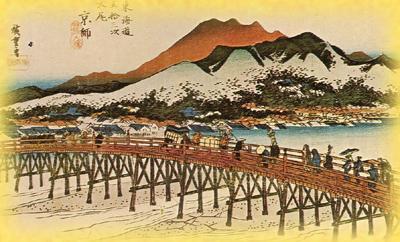 |
|
Capital from the East |
|
The emperors themselves moved constantly from the imperial residence to various noble houses because of fires in the palace. Storms, fires, and epidemics periodically decimated the population. Population figures for Heian Kyo vary wildly between 100,000 and 200,000. Life in the city was characterized by uncertainty and flux. |